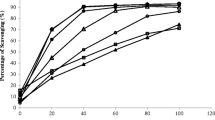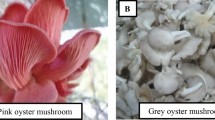Abstract
The aim of this work was to investigate the influence of two different drying methods, traditionally by sun and controlled temperatures of 45, 50, 60 and 70 °C and relative humidity of 20 and 30% on the chemical composition of Sepia officinalis. When compared to fresh samples, lipid content increased under both drying methods whereas protein levels significantly increased only under controlled conditions. Drying procedures increased the percentage of saturated fatty acids mainly in sun-dried samples and at high temperature (70 °C). A significant decrease in the amount of polyunsaturated fatty acids was detected in sun-dried samples. No significant differences were found between the levels of polyunsaturated fatty acids of fresh cuttlefish and those under controlled conditions. The highest value of malondialdehyde in mantles was observed in sun-dried samples, while in tentacles the highest level was seen at 70 °C. The highest level of advanced oxidation protein products was noted in traditionally sun-dried samples. The results obtained showed that 45–50 °C and 20–30% humidity conserved the value of proteins and lipids more than traditional drying. Results of this study may be suitable for developing a reliable industrial index.



Similar content being viewed by others
References
Özyurt G, Duysak O, Akamca E, Tureli C (2006) Seasonal changes of fatty acids of cuttlefish Sepia officinalis L. (Mollusca: Cephalopoda) in the north eastern Mediterranean sea. Food Chem 95:382–385
Forsythe J, Derusha R, Hanlon R (1994) Growth, reproduction and life span of Sepia officinalis (Cephalopoda: Mollusca) cultured through seven consecutive generations. J Zool 233:175–192
Ozogul Y, Duysak O, Ozogul F, Ozkutuk AS, Tureli C (2008) Seasonal effects in the nutritional quality of the body structural tissue of cephalopods. Food Chem 108:847–852
Tir M, Rebeh I, Telahigue K, Hajji T, Mejri H, El Cafsi M (2015) Seasonal variation of the chemical content and fatty acid composition of mantle and tentacle of male and female Sepia officinalis. J Am Oil Chem Soc 92:1643–1650
Rahman MS (2006) Drying of fish and seafood. In: Mujumdar AS (ed) Handbook of industrial drying. CRC Press, Boca Raton, pp 547–559
Zakhia N (2002) Adaptation of a quality assurance methodology to traditional fish drying in Mali, in Food Safety Management in Developing Countries. In: Proceedings of the international workshop CIRAD-FAO (11–13 December 2000, Montpellier, France), Hanak E, Boutrif E, Fabre P and Pineiro M (eds), CIRAD-FAO
Hamrouni-Sellami I, Rahali FZ, Rebey IB, Bourgou S, Limam F, Marzouk B (2013) Total phenolics, flavonoids, and antioxidant activity of sage (Salvia officinalis L.) plants as affected by different drying methods. Food Bioprocess Technol 6:806–817
Orphanides A, Goulas V, Gekas V (2013) Effect of drying method on the phenolic content and antioxidant capacity of spearmint. Czech J Food Sci 31:509–513
Nguyen VT, Vuong QV, Bowyer MC, Van Altena IA, Scarlett CJ (2015) Effects of different drying methods on bioactive compound yield and antioxidant capacity of Phyllanthus amarus. Dry Technol 33:1006–1017
Valdenegro M, Almonacid S, Henríquez C, Lutz M, Fuentes L, Simpson R (2013) The effects of drying processes on organoleptic characteristics and the health quality of food ingredients obtained from goldenberry fruits (Physalis peruviana). Open Access Sci Rep 2:642
Hassini L, Azzouz S, Peczalski R, Belghith A (2007) Estimation of potato moisture diffusivity from convective drying kinetics with correction for shrinkage. J Food Eng 79:47–56
Toujani M, Hassini L, Azzouz S, Belghith A (2011) Drying characteristics and sorption isotherms of silverside fish (Atherina). Int J Food Sci Technol 46:594–600
Lowry OH, Rosebrough NJ, Farr AL, Randal RJ (1951) Protein measurement with the folin phenol reagent. J Biol Chem 193:265–275
Folch J, Lees M, Sloane-Stanley GA (1957) A simple method for the isolation and purification of total lipids from animal tissues. J Biol Chem 226:497–509
Cecchi G, Basini S, Castano C (1985) Méthanolyse rapide des huiles en solvent. Rev Fr Corps Gras 32:163–164
Draper HH, Hadley M (1990) Malondialdehyde determination as index of lipid peroxidation. Methods Enzymol 86:421–431
Kayali R, Cakatay U, Akcay T, Altug T (2006) Effect of alpha-lipoic acid supplementation on markers of protein oxidation in post-mitotic tissues of ageing rat. Cell Biochem Funct 24:79–85
Gokoglu N, Yerlikaya P, Cengiz E (2004) Effects of cooking methods on the proximate composition and mineral contents of rainbow trout (Oncorhynchus mykiss). Food Chem 84:19–22
Puwastien P, Judprasong K, Kettwan E, Vasanachitt K, Nakngamanong Y, Bhattacharjee L (1999) Proximate composition of raw and cooked thai freshwater and marine fish. J Food Comp Anal 12:9–16
Finot PA (1997) Effects of processing and storage on the nutritional value of food protein. In: Damodaran S, Paraf A (eds) Food protein and their applications. Marcel Dekker Inc, New York, pp 551–577
Machiels D, Istasse L (2002) La réaction de Maillard; importance et applications en chimie des aliments. Méd Vét 146:347–352
Akinneye JO, Amoo IA, Bakare OO (2010) Effect of drying methods on the chemical composition of three species of fish (Bonga spp., Sardinella spp. and Heterotis niloticus). Afr J Biotechnol 9:4369–4373
McGill AS, Hard R, Burt JR (1974) Hept-cis-4-enal and its contribution to the off flavour in cold stored cod. J Sci Food Agric 25:1477–1489
Kabahenda MK, Omony P, Hüsken SMC (2009) Post-harvest handling of low-value fish products and threats to nutritional quality: a review of practices in the Lake Victoria region. Regional programme fisheries and HIV/AIDS in Africa: investing in sustainable solutions. The WorldFish Center. Project Report 1975
Garcia-Arias MT, Pontes EA, Linares MCG, Garcia-Fernandez MC, Sanchez-Muniz FJ (2003) Cooking-freezing-reheating (CFR) of sardine (Sardina pilchardus) fillets. Effect of different cooking and reheating procedures on the proximate and fatty acid compositions. Food Chem 83:349–356
Gladyshev MI, Sushchik NN, Gubanenko GA, Demirchieva SM, Kalachova GS (2007) Effect of boiling and frying on the content of essential polyunsaturated fatty acids in muscle tissue of four fish species. Food Chem 101:1694–1700
Nikoo M, Rahimabadi EZ, Salehifar E (2010) Effects of frying-chillingreheating on the lipid content and fatty acid composition of cultured sturgeon (Huso huso, Beluga) fillets. J Aquat Food Prod Technol 19:120–129
Chedoloh R, Karrila TT, Pakdeechanuan P (2011) Fatty acid composition of important aquatic animals in Southern Thailand. Inter Food Res J 18:783–790
Sriket P, Benjakuls S, Visessanguan W, Kijroongrojana K (2007) Comparative studies on chemical composition and thermal properties of black tiger shrimp (Penaeus monodon) and white shrimp (Penaeus vannamei) meats. Food Chem 103:1199–1207
Wu T, Mao L (2008) Influences of hot air drying and microwave drying on nutritional and odorous properties of grass carp (Ctenopharyngodon idellus) fillets. Food Chem 110:647–653
Borquez R (2003) Stability of n-3 fatty acids in fish particles during processing by impingement jet. J Food Eng 56:245–247
Fu X, Lin Q, Xu S, Wang Z (2015) Effect of drying methods and antioxidants on the flavor and lipid oxidation of silver carp slices. LWT Food Sci Technol 61:251–257
Schneedorferova I, Tomcala A, Valterova I (2015) Effect of heat treatment on the n-3/n-6 ratio and content of polyunsaturated fatty acids in fish tissues. Food Chem 176:205–211
Weber J, Bochi VC, Ribeiro CP, Victorio Ade M, Emanuelli T (2008) Effect of different cooking methods on the oxidation, proximate and fatty acid composition of silver catfish (Rhamdia quelen) fillets. Food Chem 106:140–146
Turhan S, Ustun NS, Altunkaynak TB (2004) Effect of cooking methods on total and heme iron contents of anchovy (Engraulis encrasicholus). Food Chem 88:169–172
Chen N, Zhao M, Sun W (2013) Effect of protein oxidation on the in vitro digestibility of soy protein isolate. Food Chem 141:3224–3229
Feng X, Ahn DU (2016) Volatile profile, lipid oxidation and protein oxidation of irradiated ready-to-eat cured turkey meat products. Rad Phys Chem 127:27–33
Rysman T, Van Hecke T, Van Poucke C, De Smet S, Van Royen G (2016) Protein oxidation and proteolysis during storage and in vitro digestion of pork and beef patties. Food Chem 209:177–184
Author information
Authors and Affiliations
Corresponding author
About this article
Cite this article
Tir, M., Bejaoui, S., Chetoui, I. et al. Effect of Different Drying Procedures on the Nutritional Value of the Mantle and Tentacles of Sepia officinalis . J Am Oil Chem Soc 94, 1313–1322 (2017). https://doi.org/10.1007/s11746-017-3028-5
Received:
Revised:
Accepted:
Published:
Issue Date:
DOI: https://doi.org/10.1007/s11746-017-3028-5




